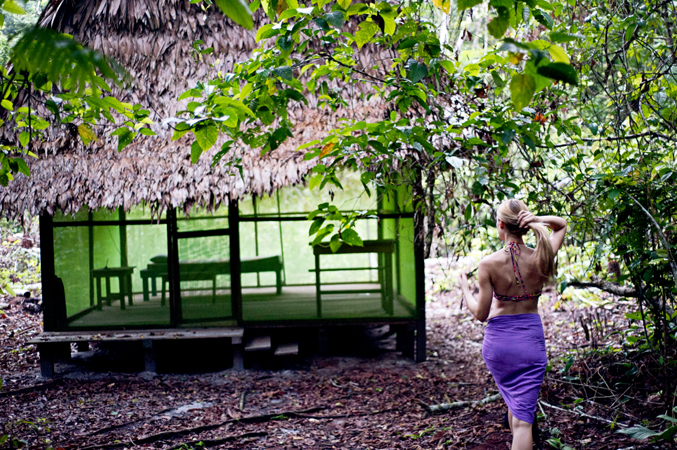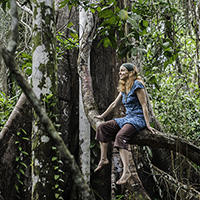Zuzanna Buchwald in the sweltering jungle heat by a secluded tambo (solo hut) at Nihue Rao. Photo by Tracey Eller.
Klara Souklava first traveled to the Amazon to experience ayahuasca ceremonies with hopes of healing deep wounds from her past. She had issues of self-love, trust issues with men, and the trauma of a rape to work through. Souklava dove deep, working with three male shamans whom she trusted implicitly at the time.
She now sees that she was too trusting and open with the shamans, and within the first three months of her visit to the Peruvian jungle, Soukalova had “some highly questionable and sexually inappropriate incidents” with one of them. She realized that “the shamans were not enlightened beings but normal men—some abusing their powers as healers.” This, of course, played perfectly into the very wounds Souklava was trying to heal.
Zuzanna Buchwald at an ayahuasca retreat in the Amazon jungle.
Souklava was fortunate. She was able to leave the unethical shaman and find ethical female shamans who brought a warmer, more nurturing energy to ayahuasca ceremonies. She found profound healing and is now sharing her healing story with people from around the world at Temple of the Way of Light, a women-centered ayahuasca healing center in the Peruvian Amazon. She’s also speaking out about her experience with the predatory shaman in hopes of helping women distinguish between highly trained, experienced, ethical and loving shamans and poorly trained or imitation shamans, as well as how to recognize any shaman who wants power, money, control, fame, or sex. As ayahuasca becomes a global phenomenon, fame and fortune can corrupt even highly trained, experienced shamans.
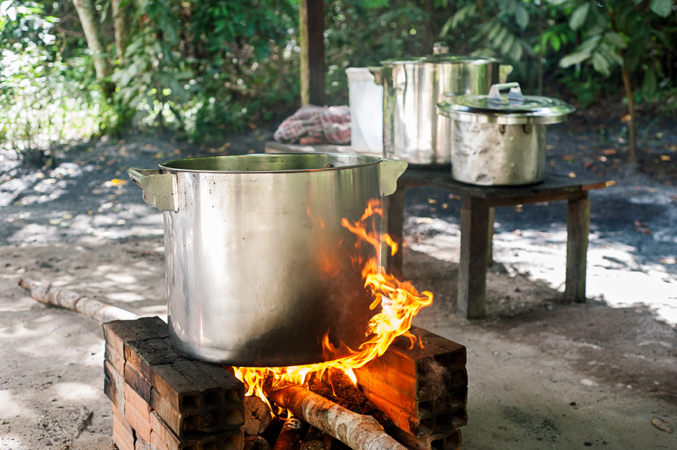
Nihue Rao’s traditional ayahuasca is small-batch artisan-crafted on site. Photo by Tracey Eller.
Altered States + Consent
Ayahuasca is a powerful hallucinogenic blend of at least two plants native to the great Amazon, the ayahuasca or caapi vine (Banisteriopsis caapi) and the leaf of chakruna (Psychotria viridis). Additional Amazonian medicinal plants are sometimes added but these two plants must be present for the medicine to work: the caapi vine, which contains a group of MAO-inhibiting (monoamine oxidase) compounds called beta carbonline alkaloids, and at least one DMT-containing companion plant such as chakruna. Drinking ayahuasca puts people into a vulnerable altered state where, in a safe set and setting, they can make powerful personal discoveries. As with other powerful “sacred plant” medicine traditions, the Vine of the Soul has emerged from its native Amazonia and is now practiced around the world.
Sex with a shaman while under this influence, or even within a certain time range of having partaken of that brew and ceremony, can never be consensual. Sitaramaya, a Los Angeles-based plantswoman and Shipibo-trained shamanic practitioner, agrees. “When you’re working with a shaman, there’s no consent because you’re under the influence of a psychoactive potion and the enchantment of the shaman,” she says.
There’s no shortage of authentic male Amazonian shamans with strong codes of ethics. Sadly, however, there are also far too many who are masters at seduction and coercion. The abuses they carry out range from fondling or groping people during ceremonies, to inappropriate romantic relationships, to rape. Women, men, and transgender people can all be dramatically affected by the experience.
Writer and speaker Lily Kay Ross, a graduate of Harvard Divinity School, has spoken out about her experience at the hands of a prominent ayahuasca shaman in Ecuador because she wants people to know what could happen if they unwittingly put themselves into the hands of a sexual predator. Ross says she was drugged with a brew heavily dosed with toè (Brugmansia), a plant rich in psychoactive tropane alkaloids, and then sexually assaulted for several weeks. “Consent hinges on the ability to give consent,” she says. “There are a number of things that can impede that, though perhaps none so obviously as mind-altering substances.”
Toè is a dangerously powerful psychedelic that can dramatically increase suggestibility. “The tropane alkaloids in toé are very potent, fast-acting, extremely poisonous, and powerfully hypnotic,” says ethnobotanist and medicine hunter Chris Kilham, author of The Ayahuasca Test Pilots Handbook (and my husband). “They work directly on the central nervous system. Too much toe’ can kill you. As a date-rape drug, it would be like being in a nightmarish funhouse.”
Toè is a Master Plant that has been used in South American Andean and Amazonian shamanic practice for centuries and is part of the tradition. The term “Master Plant” refers to “teaching plants” with powerful healing properties. “Like many medicines, this plant shows great value,” Kilham says, “But it must be handled with extraordinary care.” A small amount of toè may be fine under the guidance of an ethical master shaman such as Don Alberto Torres Davila of Blue Morpho, who understands that a little toe goes a (very) long way. Considered to be one of the most powerful healers in the Ucayali River region, Alberto mindfully oversees the creation of each artisan batch of ayahuasca—with exquisite results. I cherish the healing visions that I experienced in his care.
Ayahuasca is an intense experience. Everything that happens while you are “in the medicine” takes on greater significance. Ross says being in a state of openness and receptivity to suggestion, stimulus, and sensation when she was sexually assaulted deepened the wound.
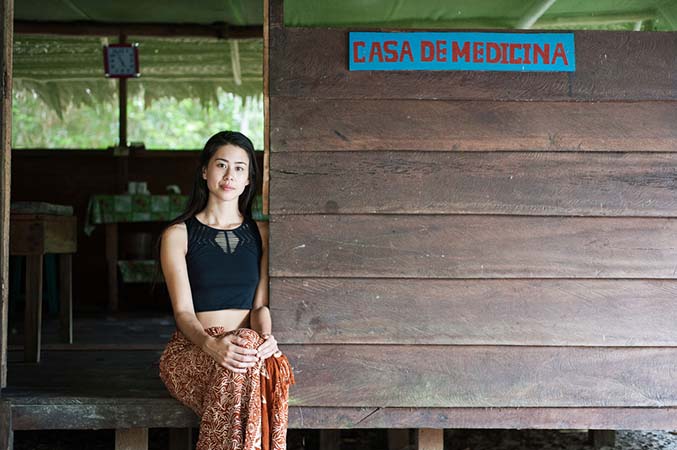
Cosmic Sister Plant Spirit Grant recipient Julia Moore at Nihue Rao’s Medicine House. Photo by Tracey Eller.
Setting Sex Aside
Since 1971, Kilham has taught yoga to thousands of people across the world, and he recognizes that people are vulnerable to spiritual advisors of all types. “Spirituality is our core essence,” he says. “The multi-layered aspects of vulnerability make that a circumstance in which you should not have any overlay of sexual engagement. In this situation, it’s fundamentally unwise and potentially injurious to engage sexually. To avoid any possibility of that, you just eliminate sex from the equation entirely. In doing so, you make the spiritual engagement safer.”
A key part of the experience at ayahuasca retreats is participating in la dieta, which calls for abstaining from ingesting alcohol, caffeine, and certain foods such as salt and sugar and from engaging in any sexual activity for a certain period before, during and after ceremony (including the full time at the retreat). In the medicine space, people often seek help with relationship and sexual issues, and engaging in sex can damage or distract from the healing process.
Avoiding sex during la dieta is purifying and prevents your energy from getting tangled up with someone else’s while you’re sorting through your own body, mind, spirit and heart during ceremony, says Dr. Joe Tafur, a medical doctor, shaman, and co-founder of Nihue Rao Centro Espiritual. He warns that having sex while taking ayahuasca affects the visions, interferes with the medicine, and could have lasting repercussions. “You might end up having to work through some other kind of healing process. So then, you just wasted a healing opportunity and created the need for another one.”
Some people experience ayahuasca as an aphrodisiac—and there’s nothing wrong with that, as long as they don’t act on it while at the retreat center. “Increased libido and more chi flow in your body is considered a sign of health,” Tafur says. “But like in many other spiritual traditions, the idea here is that you can let that energy flow through you and build and raise up your chakras—and then at the appropriate time it will be there for you.”
Abstaining from sex in this case is simply part of the ground rules and must be respected, Kilham says. “We have so many opportunities in life to engage in sexual activity. If the impulse is genuine I-have-met-my-soul-mate material, then it can wait.”
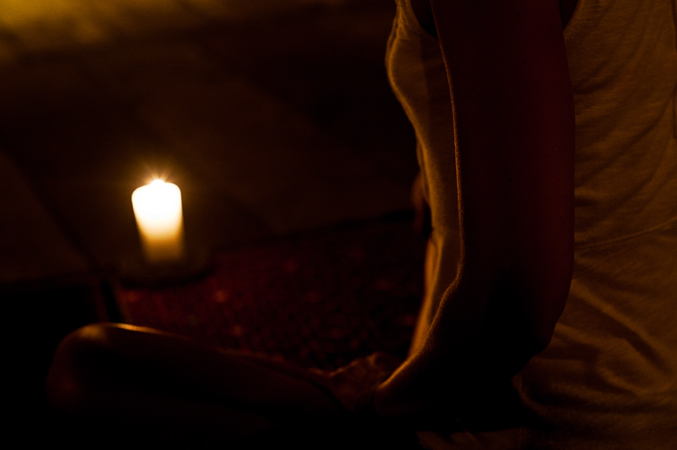
Candlelight in the maloka (ayahuasca ceremonial space). Photo by Tracey Eller.
Shaman as Predator
Ayahuasca delivers transformative effects, and many people have found the experience profoundly healing. As is the case with many spiritual or transformational experiences, it’s all too easy to confuse the profound healing la medicina delivers with the shaman who helped deliver it. As a result, people may open up and trust someone who might not have their best interests at heart, leading to devastating feelings of betrayal and confusion, and even post-traumatic stress disorder.
Soukalova speaks of witnessing beautiful young women who gave away their power to men they wouldn’t have had the time of day for outside the retreat center. The sinister shamans convinced the vulnerable, susceptible young women that they were special, “the chosen one,” she says.
But predators don’t always look or feel like creepy guys in the movies. On the contrary—they’re often charming and charismatic. “Seduction in this context is part of a larger predatory repertoire, one of many tools along with manipulation, promises of spiritual, emotional, even physical healing, and the administration of substances known to elicit strong feelings of sexual desire,” says Ross. “It’s a weighty tool belt these shamans are carrying.”
When an unethical shaman recognizes behaviors that identify an individual as vulnerable, she or he becomes prey. “They use their energy—like vampires—then drop them when they are no longer useful,” says Los Angeles-based integrative psychiatrist Dr. Hyla Cass. “This was a real problem in the early years of gurus and yoga—it was all pandemonium with no boundaries, and women were being screwed left and right, literally. These guys would come over from India and get all this attention and had no idea what to do with it except to exploit it, and they left a lot of damage in their wake. There is no difference now with abusive shamans.”
This is still going on in the yoga community, with several notable rape and sexual harassments lawsuit stories currently in the news. In the United States we have laws in place to protect and defend victims of sexual harassment when it comes to doctors, teachers, bosses and so forth, but there are no comparable laws to discourage perpetrators in a mostly underground shamanic scene. What we’re looking at here is a rapidly-expanding community of truth-seekers being called to explore a profound mind-body-spirit wellness experience, converging with a motley menagerie of fools, woo-woo wannabes, or predators who have no business leading ceremonies seeking vulnerable prey.
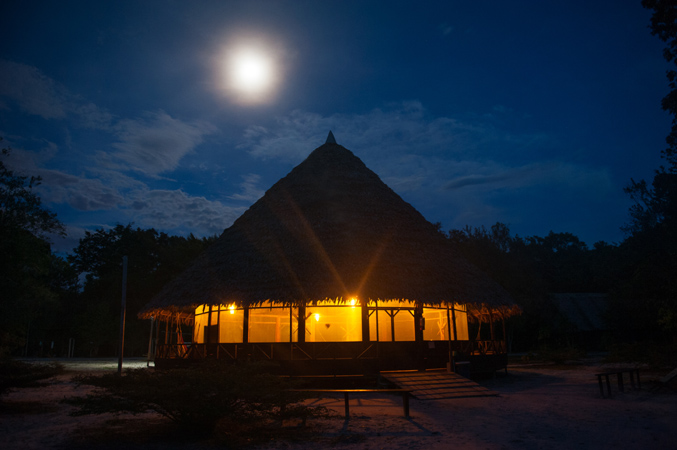
Nihue Rao’s traditional ayahuasca is small-batch artisan-crafted on site. Photo by Tracey Eller.
Boundaries Are Crucial
Attraction to charismatic leaders in positions of power is part of being human—it is not “wrong.” It’s far too easy, however, for vulnerable women with histories of sexual abuse to confuse this “strong energy connection” with love, says Cass. If a shaman attempts to seduce you, it doesn’t make you special. It makes you a target. Shamans who demand sex, additional money, agency or connections, Sitamaraya adds, “are not doing their job.”
A history of sexual abuse “often leads to blurred boundaries,” which makes people more vulnerable to predators, says Tafur. Sexual advances from a shaman can be especially confusing, which is why strict rules are in place about sex between licensed therapists and patients, teachers and students, bosses and employees, et cetera. It is why there are codes of ethics in the yoga community about sex in professional settings. “It comes with the territory,” Cass says. “It may look like consenting adults but on an unconscious level in those kinds of relationships, there is another script going on that’s exploitative. It is not love; it is not a relationship of equals.”
Seduction takes two. Kilham says people have an obligation to find another shaman if they suspect they’re being preyed upon. “Your own sense of your self-preservation should kick-in and lead you elsewhere,” he says. Ethnopharmacologist Dennis McKenna, author of Brotherhood of the Screaming Abyss, agrees. “There’s a certain responsibility on both sides,” he says. “Trying to seduce the shaman is also inappropriate and unhealthy.”
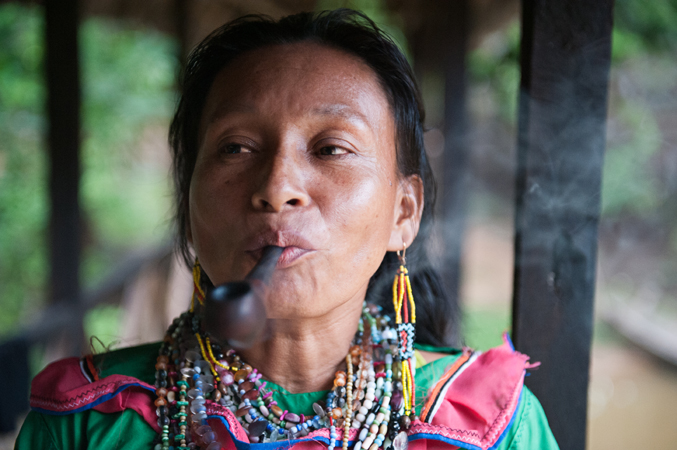
Shaman Estella smokes mapacho, a potent Amazonian tobacco, considered to be a sacred plant and master teacher, and used in protective “soplars”. Photo by Tracey Eller
Women-Led Ceremonies
Souklava believes the women-led ceremonies at Temple of the Way of Light provide an extra layer of safety and comfort for women—particularly those who have sexual issues to heal. Annie Oak, co-founder of the Women’s Visionary Congress, concurs. “Participants of all genders tell us that they welcome working with a woman ceremonial leader,” she says. Carlos Tanner, founder of Ayahuasca Foundation, has found that as well. “Some people’s issues are deeply rooted in gender, and for those people, it seems like being in a place they feel safe is really important and really helpful,” he says.
Stacy Stephen Povey, founder of the Peruvian Amazon ayahuasca retreat center Dreamglade, has heard many reports of male shamans abusing female guests and spoken personally with several women about their traumatic experiences, leading him to hire Shipibo Maestra Estella Pangosa Sinacay, a female shaman. “I really like having a feminine energy in the ceremonies here, and I even designed the maloka (ceremonial hut) with that in mind. With Estella at the helm, our ceremonies have a warm maternal vibe.”
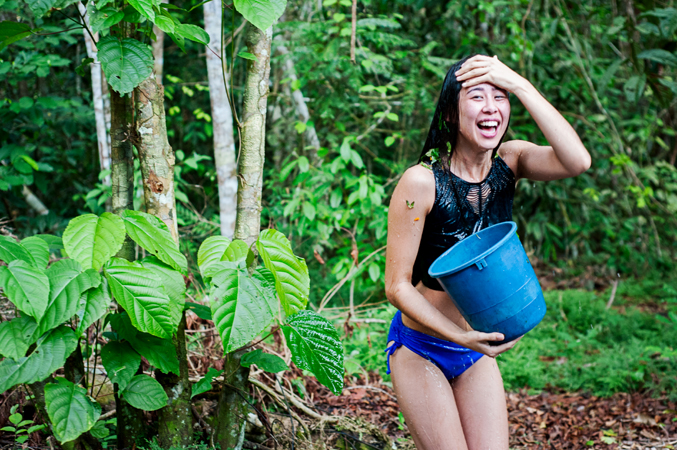
Cosmic Sister Plant Spirit Grant recipient Julia Moore, a recent sustainable food systems graduate and organic flower farmer, enjoying a refreshing ritual shamanic “flower bath” at Nihue Rao before ceremony. Photo by Tracey Eller
THE REWARDS ARE WORTH THE RISK
Ayahuasca can be an extraordinary, life-changing experience. If ayahuasca is right for you, you should have safe access to the adventure. My intention is to empower through information, advice and warnings so women can enter the ayahuasca space with a better understanding of sexual ethics and what is expected of them, the shaman, and other individuals in the surrounding community.
Understand cultural divides. Amazonian and Western cultures have different attitudes toward boundaries, sex and women. Soukalova describes Amazonian culture as “very macho, often chauvinist” and warns travelers to “take responsibility for the signals you send out. Be extremely cautious about offering friendly affection towards male healers (hugging or kissing).”
Do your homework. Research. Ask questions. Investigate. It’s a mistake to show up in Iquitos (or anywhere) and start looking for a shaman or the least expensive retreat available. Reputable ayahuasca healing centers carefully select highly trained, experienced, ethical healers and work hard to ensure a protected space. They book out months in advance. “Network to find out which are the good places and which are the bad ones,” McKenna advises. “You need to know what you’re getting into.”
Pay attention to the shaman. Walk away from shamans who claim to have special powers, thrive on authority and praise, or boast about their ancestry, lineage or power. “Authentic shamans tend to be very humble, quiet, and unassuming,” Soukalova says.
Pay attention to the brew. Always ask what ingredients are used to make the ayahuasca brew. Use extreme caution when drinking ayahuasca that has been made using toè (Brugmansia), a powerful psychedelic that can dramatically increase suggestibility. “Toé is not necessary for you to have a full and powerful ayahuasca experience,” Kilham says.
Focus on your intention. The medicine works better when you set an intention. Ayahuasca can be an intense, wild ride that can bring healing, inspiration, clarity, and revelation. Intentions help keep you safe, can help guide your journey, and serve as a centering mantra within the chaos. “It’s always about the intention,” Sitamaraya says.
Prepare yourself. Try not to take old, unhealthy patterns with you into ceremony. “Do your inner work about your sexual and intimacy issues, or they will pop up in in the Amazon, and acting them out there is not advised,” Cass says. If you feel that you are vulnerable to sexually based self-destructive behaviors, ask someone you trust for help.
Respect the agreement. The basic dieta includes abstaining from any form of sexual activity. That’s the agreement. Respect yourself and others by sticking to it. “First is to respect the diet and the healing process,” says Tafur. “Wait till your diet is closed.” When in doubt, wait until you are deep in the medicine and ask the ayahuasca, “What is this really about?” You will likely receive a jewel of wisdom.
Stick together. Find a buddy while you’re traveling and at the retreat center and keep an eye out for each other. Discuss in advance what one person should do if the other appears to be in danger of being targeted or is showing signs of self-destructive behavior. “Let each other know what types of issues should be red flags and promise each other to speak honestly and frankly about what you’re seeing if you think that something is off,” Sitaramaya advises.
Protect your space. While at the retreat, protect yourself and your personal space. Trust your intuition. If something doesn’t feel safe—walk away. If anyone encourages unhealthy choices (such as sex with the shaman), you are in a dangerous place. “Your best recourse is to remove yourself from the situation as soon as possible,” says Ross.
Allow time to integrate. Post-ayahuasca integration is a vital phase of the process. Turn down sexual or romantic advances from any person during your time at the retreat and preferably for at least a week afterward, if not longer. Allowing ample time to integrate your ayahuasca experience and the brew to be fully out of your system is the smart thing to do. “Take special care of your physical and mental state,” advises Oak.
